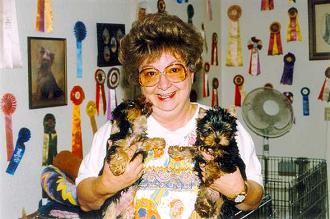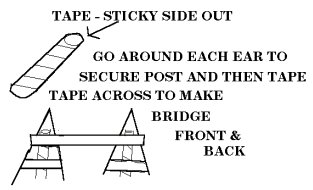
|

|

|

|
|
Alex and Terri's Yorkie Care FAQ Pages |

Terri and her cute Yorkie Puppies |
 I need some tips on house training my Yorkie puppy. Should I paper train, crate train, or what?
I need some tips on house training my Yorkie puppy. Should I paper train, crate train, or what?
|
||||
 Housebreaking a toy dog is not difficult but a job that most people seem
to have difficulty at. I can assure you that if you were housebreaking
a Great Dane, you would watch the dog like a hawk cause it's no longer a
puddle -- It's a lake!
Housebreaking a toy dog is not difficult but a job that most people seem
to have difficulty at. I can assure you that if you were housebreaking
a Great Dane, you would watch the dog like a hawk cause it's no longer a
puddle -- It's a lake!
There are two methods of potty training, and if the weather where you live is not too harsh, it's okay to train them to go outside, if they're old enough....at least 5-6 months....if not, then you may want to consider Litter Box Training. Your dog needs to interact with you. Never tie them up or leave them out on the deck or yard for too long without being there to talk to them and interact with them. Dogs are a social animal and need this contact. They need to feel that they are a part of the family, and that means being in the house, even when the family may not be in the house. If you deprive your dog of that feeling of belonging and being part of the family, it can do great psychological damage to him and he can become neurotic or psychotic. Problems with digging, fence jumping and barking are just a few of the ways neurosis can manifest itself. It's deplorable to buy a dog and chain them outside all the time because you're too tired, busy, or lazy to train them. You must invest some time and lots of praise to have a canine companion that will be devoted to you for a lifetime. It's worth the time you will invest. When the dogs are young, they all go through destructive behavior and most of them outgrow it and eventually you will feel safe leaving him alone in the house. Please remember that if you allow the dog to "go" all over the house when he first comes to your home, he will go back to where he smells it. Normally, a dog will not urinate or defecate where he sleeps, because then he would have to lie next to it. Crates aren't cheap, but sometimes you can pick up one second-hand without having to put out a lot of money, in the classified or at yard sales. Buying a Crate: Most pet shops, dog shows, or kennel supply houses carry crates. The price depends on where you purchase the crate and the size of the dog. You will probably spend anywhere from $40 to $60 for a crate, but it will last for a lifetime. The Fibreglass or Plastic ones are easier to keep clean as they won't rust like wire crates, and they aren't as noisy as the wire collapsible crates are, and considering that this is the safest way for your dog to travel, you've bought him his "dog house" and "car seat" in one package. Your dog's crate should be just big enough for him to stand up, lie down and turn around in..no bigger. The reason for this is so that he can't piddle in one corner and sleep in the opposite corner. This teaches the dog control. As the puppy gets older, he will be able to "hold it" longer and by 6 months should be able to spend an entire night without having to relieve himself. Be sure to let the puppy relieve himself before you shut him in the crate for the night. DO NOT let the puppy out when he is crying!! If you do, you have just taught the puppy he can get his way by being vocal. Always wait until the puppy is quiet before you let him out of his crate. There is an exception to that rule, and that is when you get home after the puppy has been in the crate for a while. The excitement of your return will make your puppy need to "go" so you should take him immediately to the designated "spot" and praise him exuberantly when he does his thing. Do this same thing in the morning, after he has been crated at night. Crate training the Adult dog is a little harder but patience, persistence, and a set of ear plugs should get you through this. Put his bed and toys into the crate and throw in a treat that he loves, and tell him "bedtime" or "crate time." Tell him how wonderful he is for going "in the crate." Play with him for a minute and then close the door when he is comfortable in the crate. Do this a few times and use the same command each time. Put him in there if he refuses and praise him for going to the crate...Good Boy! Keep repeating this command and getting him in the crate until he realizes he will get a reward for going in the crate and eventually you will let him out. You must be consistent. Once the dog will go in there on command, and you can leave him there for a few minutes without crying, you can increase the amount of time that he is in the crate, a little bit more each time. Always be sure he has been to the "potty" before crating. With small dogs, it's sometimes easier in the beginning to put them in the crate at eye level at night, like on your bed stand night table.  What can I do to help my new puppy adjust to our house?
What can I do to help my new puppy adjust to our house?
|
||||
 1. Set up a schedule and follow it consistently.
ALWAYS feed, walk, socialize, put out to make,
etc., your dog at the same time. Like the rest of us,
dogs feel much more comfortable if they know
what to expect. Follow this schedule for at least 4
to 6 months, as it will take the dog some time to
feel "at home".
1. Set up a schedule and follow it consistently.
ALWAYS feed, walk, socialize, put out to make,
etc., your dog at the same time. Like the rest of us,
dogs feel much more comfortable if they know
what to expect. Follow this schedule for at least 4
to 6 months, as it will take the dog some time to
feel "at home".
2. Be consistent. Not just with the schedule, but with everything you do with your dog. Decide on the rules the dog will live by and then stick to those rules. Dogs learn much more quickly and behave much better if you are consistent in your actions and expectations. Consistency must start the minute you get the dog home. Everyone in the household needs to agree on the rules for the dog, how those rules will be taught and how they will be enforced. This means that you will need to be prepared for the dog BEFORE he comes home. Be fair to the dog -- don't get him on the spur of the moment. Be ready for him. Dogs don't just walk in the front door and say to themselves "Oh...there's the potty". They need to be trained where to relieve themselves even if they are already housebroken. A new house means new rules and you MUST TEACH HIM the rules. 3. Don't get angry. Anger doesn't teach -- it may be understood as a threat or a challenge by the dog. Either way, it doesn't lead to the desired response. Deal with disobedience by using quick, matter-of-fact corrections. Don't get your emotions involved. Many problem behaviors are not the result of the dog's attempt "to get even" but rather a result of being bored, lonesome, frightened or having learned to get attention by some undesirable means. 4. Pack leader. A leader is clear, concise, consistent. Dogs understand and need to have a pack leader. If you don't assert your right to that position the dog will naturally move into the leadership role. That means that the sofa is his, the garbage is his, the Thanksgiving turkey is his, and the new pair of shoes you just bought is his. In short, he is in control. Leaders don't come when called. Leaders may bark when and how long they want. Leaders may bite. Think about it.. Often common behavior problems are caused by the dog's assertion of leadership rights over at least some members of the family. If you are not familiar with "pack leadership" as it pertains to the family dog and training, read Is Herbert There? A Survival Guide for Pet Owners, by Animal Behavior Consultant, Terry Jester. 5. Enroll in Training Classes. Training classes help you communicate with your dog. Learning to obey when there are lots of other dogs and people around helps build confidence in both the dog and owner. Owners who work with their dogs find that the mental exercise is just as important as physical exercise for keeping the dog from becoming bored. It is a proven fact that people who put in the effort to obedience train their dogs and maintain the training have fewer problems with their dogs. An added bonus is the working bond that develops between the dog and the owner when they spend time training together. Just because you own a small dog doesn't mean that obedience training is unnecessary. Do be sure that your instructor is mindful of the fact that you have a small dog and separates the classes by sizes or at least moves them separately in the classes until all the dogs are "under control". 6. Praise. Praise is the reward the dog receives for obeying your command. There are some simple rules for giving praise/rewards: A) Make the reward immediate. Praise delayed = praise denied. B) Reward the dog only for obedience. He doesn't get any praise without earning it. C) Praise should be short-term. Only a few seconds of patting is enough. D) Don't use food as the primary type of reward. 7. Be positive. Tell the dog what you want him to do instead of what you don't want. It is easier for the dog to understand one positive command (like "down") instead of a series of negative commands (don't chase the cat, don't jump off on the sofa, don't bark). Being positive enforces the idea that you are the leader because you give and enforce commands. A) Giving commands gives definite direction. B) Obedience earns a reward (praise) for the dog. C) It puts you in control. 8. Let him be a dog. Enjoy him, train him, have fun with him. Do not expect him to make decisions. That's your job -- you're the leader. Expect him to act like a dog -- nothing more, but certainly nothing less. Dogs are intelligent, energetic and very adaptable. Given the right training and being respected for the qualities that have made them "man's best friend" for thousands of years, dogs can become very good companions and valued members of the household. Without training, proper care, or an understanding of how dogs think, feel and react, these four-footed creatures can become problems to both owner and neighborhood, and not give the pleasure that good training can create.  Where can I get a Yorkie puppy and how do I find a good breeder?
Where can I get a Yorkie puppy and how do I find a good breeder?
|
||||
 Basically, breeders fit into six categories
and like every business there are levels of
desirability. The Well Known High Profile
Professional, Well Known Professionals Who
Exhibit and Advertise regularly, Dedicated
fanciers, who do little advertising and are totally
unconcerned about statistics, but regularly show
up at Specialty Shows and who also regularly
exhibit and finish dogs to their Championships
generation after generation. Also there are the
OK's, Not-So-Hots, and "I'll do or say anything to
make a Dollar" breeders. It is important to stick
with the first three groups and avoid the others.
Basically, breeders fit into six categories
and like every business there are levels of
desirability. The Well Known High Profile
Professional, Well Known Professionals Who
Exhibit and Advertise regularly, Dedicated
fanciers, who do little advertising and are totally
unconcerned about statistics, but regularly show
up at Specialty Shows and who also regularly
exhibit and finish dogs to their Championships
generation after generation. Also there are the
OK's, Not-So-Hots, and "I'll do or say anything to
make a Dollar" breeders. It is important to stick
with the first three groups and avoid the others.
First, it is important to distinguish between Professional Breeders and "back yard" breeders or so called "kitchen" breeders. The Professionals, be it hobby or commercial, make their living or part of their living by raising, showing and selling dogs. They usually have many years of study and experience in the art and science of creating the best qualities in the breed they are selling. The "kitchen" breeder or "back yard" breeder may breed their female once to show the kids how puppies are born, or may mate little "Fifi" with the dog down the street with no research or knowledge as to whether the animals or their pedigrees are compatible. They just "make puppies", and usually offer no replacement guarantee, etc. Like the professional, the dedicated fancier also considers their reputation very important, has been in the same breed for ten years or more and is probably into their third generation of the breed. The fancier is not so much concerned about the price of the dog as they are about the "placement" of the dog, regardless of the price. However, make no mistake about it, dogs from the fancier will not be cheap either considering the high cost of veterinary care and consultation these days, as well as the high cost of quality food and other supplies. The fancier doesn't care about making a profit, but would like to meet the expenses of raising the dogs. Although buying from a professional or fancier offers no guarantee of getting a quality puppy, as all living things mature differently, it typically is a lot safer than buying from an amateur whose experience is limited to breeding their own dog once or twice, like the "kitchen or back yard" breeders. Finding a good breeder or fancier is probably as hard as finding a good anything. They are few and far between. However, since starting out with a well-bred dog will spare you more problems and save you more money than you know, it is always worth the time it takes to find one. One rule of thumb is that the more a breeder seems to want to sell you a dog, the faster you should leave the premises. The best and most qualified breeders never "try" to sell any dog. They are too busy deciding if you are good owner material. These people are in it for the long term and take their business, be it professional or hobby fancier, very seriously. They are not selling you a "product". They are letting you adopt someone they love. They will know each pup's name and the warm emotion in their voice as they describe each distinct personality will assure you that your future pal has been well taken care of, physically and emotionally. Many breeders breed for show champions and have no interest in a dog unless they can add to the prestige and price of their breeding lines. They have been known to practically kick dogs out of their facilities, and have too many dogs for individual handling and attention; however, they may sell cheap just to "get rid" of their breeding excess. I strongly advise against buying a puppy or older dog from this kind of breeder because they are not really interested in YOU, either. These people will try to wow you with a list of titles and awards a mile long. Their prices may tend to be higher than average if they want to prove to you that their dogs are something special, or really cheap if its something they hate and want to "get it out of there". If this latter breeder somehow feels like a "hype-job", believe it and move on. Also, it is a good idea to remember that just because a dog is a show champion doesn't mean that he or she has the kind of temperament that fits in well with family life. Very often, these dogs have been neglected in household amenities, like paper training, or even abused by handlers who have no business being handlers and MIGHT BE temperamental nightmares. The most important thing for a prospective owner to do is to learn everything they can about the breed they are interested in and then go out "shopping". The more Dog Shows you attend and Breeders you visit, the more you will appreciate the real thing when you find it. Also be honest with the Breeders about your intentions. Don't insist you only want a "pet" because you think that will be cheaper and then moan and complain later because you did not get a dog that you can "show and breed". AKC does offer the breeder an avenue of escape in the "limited" registration of the PURE BRED DOG. You can register this dog but no puppies from this dog can ever be registered with AKC unless the Breeder applies to AKC to reverse the "limited" registration when the dog reaches maturity. Some basic things to look for as you visit Breeders are: that the pups and their surroundings are clean; how many puppies there are-- the more the merrier; at least one, but preferably both of the parents are on-site; there is a contract that spells out the breeder's liability and a guarantee on health and temperament; the price is competitive -- very expensive puppies are rarely worth it; don't rush it -- you are choosing a potential member of the family; trust your gut feelings. If it doesn't feel right, don't do it. Don't take home a puppy under twelve weeks of age. Let the breeder get a couple of Immunization shots in that pup before you bring it home. Reputable breeders will be happy to take a deposit on a pup and keep it for you until twelve weeks. It will give your pup a better start. Don't meet your breeder at a local parking lot, restaurant, or other meeting place. Insist on seeing where your puppy lives. Remember that "one time" or so called "kitchen" pet breeders may not ever breed their dog again so your chances of getting your money back or a replacement puppy should something happen to your puppy are limited if you are dealing with this kind of breeder. Don't buy a puppy just to save it from a filthy life.. you're better off turning those people in and letting the authorities deal with them! The right dog and breeder for you is out there if you take the time to find them. The same information applies to shopping for your show dog as in the previous answer, except that: You DO NOT want to CO OWN a SHOW DOG. This is probably the most foolish way to purchase any dog and most especially a Show and Breeding Dog. I could probably count on one hand the amount of Co-Ownerships that reached an ending with both parties still "liking" each other; even less, if you're looking for any Co-Ownerships that reached an ending with all parties still admiring and respecting each other. You DO NOT want to buy a show dog until after the second teething (6-7 mos) and preferably not until ten months of age. You should also be sure that your bill of sale has a guarantee in writing of how this will be handled if your dog develops liver disease, L'egg Perthes, or any other disease which makes it impossible for you to show or breed. You are better off starting out with a sound female from free whelping lines, preferably line bred, however, it is perfectly alright to find a good sound breeding or show bitch who is a result of an outcross breeding (that means where the ancestors are not related) and breed her back into the lines that have the characteristics you like in the breed. It is almost always to your advantage to take the breeder's advice as to how she should be bred . The very best bloodlines have some problems that must be weeded out. In order to do an intelligent job of breeding, you must know where these problems exist. Be very direct with the breeder from whom you buy your foundation bitch and let them know that you want to know any problems up front so you can form a healthy relationship and a good future in healthy, beautiful and sound stock. Be wary of the breeder who tells you they NEVER HAD ANY PROBLEMS OF ANY KIND in their line. This person is probably not being truthful, or else hasn't been breeding long enough to learn how to cull their litters, do test breedings, and thus perfect their line. Make notes of the Breeder's experience of problems encountered with different dogs in the breed. After purchasing your bitch, you may find other breeders who are willing to give their opinion on your bitch, but don't expect them all to be perfectly honest with you. They may very well be too intimidated to give their honest opinion, or envy may cloud their judgement. The best way to get an honest opinion is to approach an AKC breeder judge at a point show and ask them whether they believe your bitch to be good enough to be bred or shown. Whether the answer is Yes or No, ask what the good points of your bitch are as well as the flaws. Bear in mind that this doesn't mean you have to search forever for the "perfect" dog. Believe me, perfection doesn't exist. If you can know the faults or eliminate them and thereby finish your dogs easily, you're better off financially whether you take the dogs to show after show yourself or hire a handler to do it. It is my opinion that every breeder should know just as much as any judge BEFORE they breed two animals. Doesn't it make sense that you cannot eliminate faults if you don't know what they are? Learn what a good front and a good rear is, and the reasons they develop that way, and the faults within your breed so that you don't double up on them. Most Professional Handlers who have ten or more years experience are very good at helping you to understand what is good and what is bad about your dog. After all, if you do breed good dogs, they may get lucky and be the one you select to show your dogs. All handlers really want good dogs to show! Some of the problems that have been coming up in Toys, as well as other breeds are: L'egg Perthes, Liver shunt, PRA, bad bites, luxation of the patellas, poor rear angulation, poor shoulder layback and lay-on, low set tails, tubular bodies with no rib spring, no neck (usually because of a poor lay-on of shoulders). If any of these terms is a mystery to you, then you're not yet ready to breed a male to a female. You cannot breed good quality dogs if you do not know how to recognize problems. Do some research and find out what these problems are so that you can recognize them and not propagate them. Toys are not easy whelpers, so if you are going to go to the trouble of breeding them, you might as well start off with a chance of producing some enviable stock, from free-whelping lines. Intensive and selective breeding and culling is used by wise breeders to eliminate problems within any breed. Anybody can "make puppies", but it takes serious planning and knowledge to improve a breed and leave it better than you found it. You will reap the rewards of your efforts. There are some very good books written by dog judges that you can read and thereby learn about movement and structure, i.e., The Nicholas Guide to Dog Judging, by A.K. Nicholas and the Dog Judges Handbook by Sari B. Tietjen.  My Yorkie puppy's ears are flopping down. Is there anything I can do?
My Yorkie puppy's ears are flopping down. Is there anything I can do?
|
||||
 It's perfectly normal for the ears to droop during teething. However, the
thickness of the ears is in the breeding and if they are too thick, they may not
come up. The ears should be trimmed on the edge about
halfway down each side, then use a clipper (the Wahl clipper is available in your
local Payless or other drug store, the kind that is used to trim the hair on the
back of the neck) with a surgical blade, about halfway down front and back of
each ear. This is usually started at about four weeks but if your puppy's ears
are still not up, you must take off the hair, massage them regularly, say once
a day, to keep the circulation going and tape them as shown.
It's perfectly normal for the ears to droop during teething. However, the
thickness of the ears is in the breeding and if they are too thick, they may not
come up. The ears should be trimmed on the edge about
halfway down each side, then use a clipper (the Wahl clipper is available in your
local Payless or other drug store, the kind that is used to trim the hair on the
back of the neck) with a surgical blade, about halfway down front and back of
each ear. This is usually started at about four weeks but if your puppy's ears
are still not up, you must take off the hair, massage them regularly, say once
a day, to keep the circulation going and tape them as shown. A dental absorber is a good post...wrap some aerated Johnson & Johnson tape backwards
so the sticky side is out and insert on the base of the ear as support and wrap more
aerated tape as shown.
A dental absorber is a good post...wrap some aerated Johnson & Johnson tape backwards
so the sticky side is out and insert on the base of the ear as support and wrap more
aerated tape as shown.Then tape a bridge between the ears with 3/4" 3M filament tape to hold them up, being careful they are in a natural position. You can keep the ears taped for a week, but then even if they haven't come loose, you must remove them and make sure the pups ears are dry and clean. Whether they are up or not, leave them alone for a day or two. Retape them if they fall again. Smell the ear and if there is an odor, you may want to ask your veterinarian for some Tresaderm. An odor could mean an ear infection and if the ear is odorous or looks swollen, don't re-tape until you've corrected the situation or seen a Vet.
but his ears never stood up. Is there any way of fixing it now?  How often should I bathe my Yorkie and what shampoos, conditioners, and oils should I use?
How often should I bathe my Yorkie and what shampoos, conditioners, and oils should I use?
|
||||
 Yorkies have a wash and wear coat. They are a single coated dog and
washing them every 7-10 days and using a good cream rinse with a drop of
oil, and spraying them with a "The Stuff" detangler as you blow them
dry is all you'll have to do other than keeping the ears trimmed on
their feet, ears and around the rectum, and keeping their nails short.
Yorkies have a wash and wear coat. They are a single coated dog and
washing them every 7-10 days and using a good cream rinse with a drop of
oil, and spraying them with a "The Stuff" detangler as you blow them
dry is all you'll have to do other than keeping the ears trimmed on
their feet, ears and around the rectum, and keeping their nails short.
Whenever you start grooming your dog, be sure the dog has good footing, both in the grooming area and in the sink.....Drydek or a bath mat will do. It's also very comforting to have warm towels from the dryer to wrap your wet dog in after bathing. You should never brush a dry coat. Always use a bristle brush and a good moisturizer spray in between baths. If the coat is badly matted, then finger separate and spray a good detangler on the coat before you bathe the dog. The very best coat shampoos and conditioners are put out by a Company called Senproco, phone 1-800-748-1777. Other good products like #1 All System and Bio Groom Products are available at www.cherrybrook.com. Alex here: Shooter and I use #1 All System -- Best shampoo, conditioner, and hemectant oil we've found!  What immunizations are required for my Yorkie?
What immunizations are required for my Yorkie?
|
||||
 My vet recommends that I give the Puppy Shot at 6, 9, 12, and 16 weeks
with no lepto. Lepto is a very painful part of the shot and my vet
recommends not giving it to toy dogs.
The Rabies Vaccine is given down on the side subquetaneously by the vet
at 6 months.
There are occasional "bald spots" caused by allergic reactions to
vaccines so I don't suggest giving it on the top where it can be readily
seen.
My vet recommends that I give the Puppy Shot at 6, 9, 12, and 16 weeks
with no lepto. Lepto is a very painful part of the shot and my vet
recommends not giving it to toy dogs.
The Rabies Vaccine is given down on the side subquetaneously by the vet
at 6 months.
There are occasional "bald spots" caused by allergic reactions to
vaccines so I don't suggest giving it on the top where it can be readily
seen.
 What's a good feeding regiment for Yorkies?
What's a good feeding regiment for Yorkies?
|
||||
 I start the puppies off with Science Diet Growth Small Bites dry
and give moist meals of the same mixed with a little Gerbers Strained
Turkey Baby Food 2 x day....Zap in the microwave for one minute (covered
with water) let sit and soak for a couple of minutes and feed warm.
I start the puppies off with Science Diet Growth Small Bites dry
and give moist meals of the same mixed with a little Gerbers Strained
Turkey Baby Food 2 x day....Zap in the microwave for one minute (covered
with water) let sit and soak for a couple of minutes and feed warm.
I leave dry food down all day and all nite for all my dogs but the adults have chosen to eat ONE Lamb and Rice. That's what they like and so that's what I feed now for at least 6 years.  Should I consider breeding my Yorkie?
Should I consider breeding my Yorkie?
|
||||
 Before you consider breeding your Yorkie, send the pedigree of your
female to several well known and trustworthy breeders. If possible go
to a dog show and try to have the Yorkie judge evaluate your puppy, to
tell you if it is good enough to be bred.
Before you consider breeding your Yorkie, send the pedigree of your
female to several well known and trustworthy breeders. If possible go
to a dog show and try to have the Yorkie judge evaluate your puppy, to
tell you if it is good enough to be bred.
Before breeding the male and female should be certifed free of brucellosis. This is a standard test that your vet can do on the 5th day of heat. Most breeders don't insist on the male being certified as free of brucellosis but it would not be unusual to expect the male to be tested also before you breed to him. There are many books available on the trials and tribulations of breeding toy dogs, and I suggest that you at least read one that lets you know what you're letting yourself in for and also buy as many whelping videos as you can. Then if you're still interested, well that's where dedicated breeders come from!! Inbreeding consists of the inter-mating of relatives, and it is virtually impossible to breed pedigree stock of any kind without having some relationship somewhere. Once a breed is established, it is impossible to breed a male and female within this breed without finding some ancestors in common. It may be so far back that you can't trace them, but by inbreeding these common ancestors, your breed was formed. Most breeders consider "outcrossing" as breeding stock who are completely unrelated in the last six generations. This is as far as most breeders trace their stocks' ancestry, unless they have personally linebred for a longer period of time. "Line-breeding" is considered to be merely a mild or less intense form of inbreeding. Mating of distant cousins, or mating dogs who come from the same kennel and same strain but who have no common ancestors closer than four or five generations behind them. "Inbreeding" condenses the genetic pool and because they are the most closely related genetically the chances of the results being very good or VERY BAD are good and should not be attempted by an amateur. Inbreeding, which I call "test breeding" is the only way to sort out faults and virtues. Whether the results are good or bad will depend on the type of stock you start with, because inbreeding cannot create good or bad points. It merely uncovers them. When results of inbreeding are disappointing, don't run to an outcross to try to solve your problems, since you will only bring in more covered-up problems. Stick it out and keep culling the results, and don't overlook a fault, because inbreeding merely intensifies a fault and makes it worse. For instance, an Outcross gives you a 1 to 1000 ratio of finding the good or bad and Inbreeding brings the chances down to 1 to 30. You must start with good sound stock and learn as much as possible about it. Only the offspring are the proof of what you can learn. The longer you inbreed, the more alike the offspring will become, but don't hesitate to eliminate from your breeding program those dogs or bitches that throw serious faults. This latter problem is where many mistakes are made and secrets are kept from new breeders. If a valuable stud or bitch begins to throw serious hereditary problems within a line, they should be eliminated from your breeding program. You are doing the breed a great injustice if your attitude is ..." All I need is one good male in a litter and it doesn't matter if the rest are lousy". The three accepted forms of inbreeding practiced by most breeders are: 1) Mating sire to his daughter and producing stock with 3/4 of the genetic makeup of the sire. This is to intensify his qualities. 2) Mating the dam to her own son or sons successively. This increases the genetic makeup of the dam. With a good brood, this promises a lot. 3) Brother and sister mating, but this is the least promising, since you are working with unknown quantities instead of the sire-and-dam matings, where you already know what their offspring are like. Ref: Hilary Harmers' "Dogs and How to Breed Them"  Is it best to have my pet Yorkie neutered?
Is it best to have my pet Yorkie neutered?
|
||||
 Unless you are going to show or breed, yes, it is best......for the
males, it makes them better pets as they are not leg lifting and leaving
"calling cards" which do not smell too good in my opinion.
Unless you are going to show or breed, yes, it is best......for the
males, it makes them better pets as they are not leg lifting and leaving
"calling cards" which do not smell too good in my opinion.
Spaying a female will decrease the change of mammary cancer in the future, and similarly, neutering a male decrease the chance testicular cancer. So yes, I would advise it for a pet.  Do I have to brush my Yorkie's teeth?
Do I have to brush my Yorkie's teeth?
|
||||
 Some dogs teeth form placque faster than others...and yes you should
brush at least once a week with Nolvadent (from your vet or supply
house) and put a drop of glyoxide (from your pharmacy) on either side of
the mouth in back once a week and get a scraper and learn how to scrape
the teeth....Omaha Vet 1-800-367-4444 has dental scrapers...
that you must do every other month.
Some dogs teeth form placque faster than others...and yes you should
brush at least once a week with Nolvadent (from your vet or supply
house) and put a drop of glyoxide (from your pharmacy) on either side of
the mouth in back once a week and get a scraper and learn how to scrape
the teeth....Omaha Vet 1-800-367-4444 has dental scrapers...
that you must do every other month.
If you don't keep the teeth clean, they will develop periodontal disease...like the dentist says...just floss the ones you want to keep.  My vet said my Yorkie has pattella problem. What's that?
My vet said my Yorkie has pattella problem. What's that?
|
||||
 Many toy dogs live their whole lives with luxating
patellas and are never lame. A "luxating patella"
would be best described as a "trick knee" which
can move out of place if injured by jumping or
walking in a hole in the ground, etc. Toy dogs are
prone to this because of their diminutive size. No
matter how firm the knees seem as puppies, toy
dogs are liable to injure their knees depending on
the degree of luxation. The grooves in the knee
where the knee fits is sometimes shallow and the
knees can be very wobbly. Most breeders do try to
breed away from this. The taller more fine-boned
dogs seem to be more prone to this kind of injury.
Many toy dogs live their whole lives with luxating
patellas and are never lame. A "luxating patella"
would be best described as a "trick knee" which
can move out of place if injured by jumping or
walking in a hole in the ground, etc. Toy dogs are
prone to this because of their diminutive size. No
matter how firm the knees seem as puppies, toy
dogs are liable to injure their knees depending on
the degree of luxation. The grooves in the knee
where the knee fits is sometimes shallow and the
knees can be very wobbly. Most breeders do try to
breed away from this. The taller more fine-boned
dogs seem to be more prone to this kind of injury.
Sometimes, if the knee pops out and stretches the ligaments that hold it in place, it becomes a chronic problem and the dog becomes lame and in this case, the first treatment would be to keep the dog crated for a week or two and supervise the activity -- no jumping from furniture and up and down behind a gate on a slippery floor, etc. Also in conjunction with that the dog should be given prednisolone to take down the inflammation. My Vet suggests 1/2 of 5 mg tablet 2 times a day for three days, 1/2 of 5 mg tablet one time per day for three days and then 1/2 of 5 mg tablet every other day four times during the crating convalescing time. Check with your Vet for the dosage and this prescription medication. Usually this period of rest will be all that is necessary to correct the situation. Surgery is very seldom the answer and should only be done by an orthopedic surgeon if the dog is lame. My vet says that if surgery is done for a luxating patella on a dog that is not lame, he can guarantee you that THAT dog will have problems with arthritis from the surgery five years down the line. Many show dogs have finished their title with at least one luxating patella. |
 Terri's Book |
Get Terri's Book -- It's excellent! Click the book for more information. -Alex |
 Vassar Square Yorkies That's Shooter's great great grandpa Mr. Skiffington |
Dr. Dale Heisler ...Or a Technical Medical question for Dr. Dale Heisler? |
Buy Yorkie Books On-Line:





|






Click the Book Cover for More Information |

